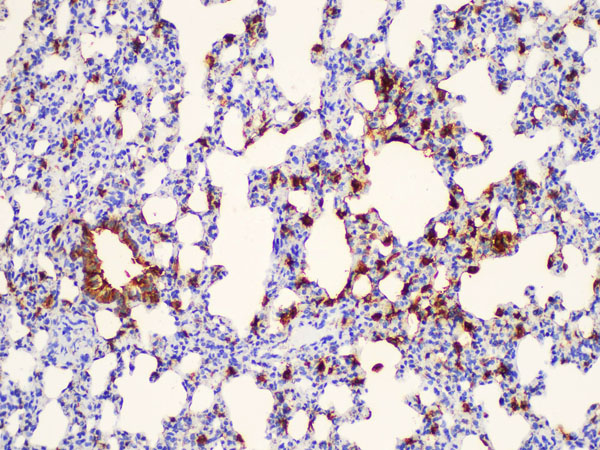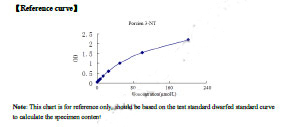Glutamate receptor 3 (GRIA3) Recombinant Protein | GRIA3 recombinant protein
Recombinant Human Glutamate receptor 3 (GRIA3), partial
Gene Names
GRIA3; GLUR3; GLURC; GluA3; MRX94; GLUR-C; GLUR-K3
Purity
Greater or equal to 85% purity as determined by SDS-PAGE.
Synonyms
Glutamate receptor 3 (GRIA3); N/A; Recombinant Human Glutamate receptor 3 (GRIA3), partial; AMPA-selective glutamate receptor 3; GluR-C; GluR-K3; Glutamate receptor ionotropic, AMPA 3; GluA3; GRIA3 recombinant protein
Host
E Coli or Yeast or Baculovirus or Mammalian Cell
Purity/Purification
Greater or equal to 85% purity as determined by SDS-PAGE.
Form/Format
Lyophilized or liquid (Format to be determined during the manufacturing process)
Sequence Positions
151-250aa; partial
Sequence
SLLGHYKWEKFVYLYDTERGFSILQAIMEAAVQNNWQVTARSVGNIKDVQEFRRIIEEMDRRQEKRYLIDCEVERINTILEQVVILGKHSRGYHYMLANL
Preparation and Storage
Store at -20 degree C, for extended storage, conserve at -20 degree C or -80 degree C.
Related Product Information for GRIA3 recombinant protein
Receptor for glutamate that functions as ligand-gated ion channel in the central nervous system and plays an important role in excitatory synaptic transmission. L-glutamate acts as an excitatory neurotransmitter at many synapses in the central nervous system. Binding of the excitatory neurotransmitter L-glutamate induces a conformation change, leading to the opening of the cation channel, and thereby converts the chical signal to an electrical impulse. The receptor then desensitizes rapidly and enters a transient inactive state, characterized by the presence of bound agonist. In the presence of CACNG4 or CACNG7 or CACNG8, shows resensitization which is characterized by a delayed accumulation of current flux upon continued application of glutamate.
Product Categories/Family for GRIA3 recombinant protein
References
Human glutamate receptor hGluR3 flip and flop isoforms
cloning and sequencing of the cDNAs and primary structure of the proteins.Rampersad V., Elliott C.E., Nutt S.L., Foldes R.L., Kamboj R.K.Biochim. Biophys. Acta 1219:563-566(1994)
McLaughlin D.P., Kerwin R.W. Characterization of the human glutamate receptor subunit 3 gene (GRIA3)
, a candidate for bipolar disorder and nonspecific X-linked mental retardation.Gecz J., Barnett S., Liu J., Hollway G., Donnelly A., Eyre H., Eshkevari H.S., Baltazar R., Grunn A., Nagaraja R., Gilliam C., Peltonen L., Sutherland G.R., Baron M., Mulley J.C.Genomics 62:356-368(1999)
Candidate gene analysis in Rett syndrome and the identification of 21 SNPs in Xq.Amir R., Dahle E.J., Toriolo D., Zoghbi H.Y.3.3.CO;2-N>Am. J. Med. Genet. 90:69-71(2000)
The DNA sequence of the human X chromosome.Ross M.T., Grafham D.V., Coffey A.J., Scherer S., McLay K., Muzny D., Platzer M., Howell G.R., Burrows C., Bird C.P., Frankish A., Lovell F.L., Howe K.L., Ashurst J.L., Fulton R.S., Sudbrak R., Wen G., Jones M.C., Hurles M.E., Andrews T.D., Scott C.E., Searle S., Ramser J., Whittaker A., Deadman R., Carter N.P., Hunt S.E., Chen R., Cree A., Gunaratne P., Havlak P., Hodgson A., Metzker M.L., Richards S., Scott G., Steffen D., Sodergren E., Wheeler D.A., Worley K.C., Ainscough R., Ambrose K.D., Ansari-Lari M.A., Aradhya S., Ashwell R.I., Babbage A.K., Bagguley C.L., Ballabio A., Banerjee R., Barker G.E., Barlow K.F., Barrett I.P., Bates K.N., Beare D.M., Beasley H., Beasley O., Beck A., Bethel G., Blechschmidt K., Brady N., Bray-Allen S., Bridgeman A.M., Brown A.J., Brown M.J., Bonnin D., Bruford E.A., Buhay C., Burch P., Burford D., Burgess J., Burrill W., Burton J., Bye J.M., Carder C., Carrel L., Chako J., Chapman J.C., Chavez D., Chen E., Chen G., Chen Y., Chen Z., Chinault C., Ciccodicola A., Clark S.Y., Clarke G., Clee C.M., Clegg S., Clerc-Blankenburg K., Clifford K., Cobley V., Cole C.G., Conquer J.S., Corby N., Connor R.E., David R., Davies J., Davis C., Davis J., Delgado O., Deshazo D., Dhami P., Ding Y., Dinh H., Dodsworth S., Draper H., Dugan-Rocha S., Dunham A., Dunn M., Durbin K.J., Dutta I., Eades T., Ellwood M., Emery-Cohen A., Errington H., Evans K.L., Faulkner L., Francis F., Frankland J., Fraser A.E., Galgoczy P., Gilbert J., Gill R., Gloeckner G., Gregory S.G., Gribble S., Griffiths C., Grocock R., Gu Y., Gwilliam R., Hamilton C., Hart E.A., Hawes A., Heath P.D., Heitmann K., Hennig S., Hernandez J., Hinzmann B., Ho S., Hoffs M., Howden P.J., Huckle E.J., Hume J., Hunt P.J., Hunt A.R., Isherwood J., Jacob L., Johnson D., Jones S., de Jong P.J., Joseph S.S., Keenan S., Kelly S., Kershaw J.K., Khan Z., Kioschis P., Klages S., Knights A.J., Kosiura A., Kovar-Smith C., Laird G.K., Langford C., Lawlor S., Leversha M., Lewis L., Liu W., Lloyd C., Lloyd D.M., Loulseged H., Loveland J.E., Lovell J.D., Lozado R., Lu J., Lyne R., Ma J., Maheshwari M., Matthews L.H., McDowall J., McLaren S., McMurray A., Meidl P., Meitinger T., Milne S., Miner G., Mistry S.L., Morgan M., Morris S., Mueller I., Mullikin J.C., Nguyen N., Nordsiek G., Nyakatura G., O'dell C.N., Okwuonu G., Palmer S., Pandian R., Parker D., Parrish J., Pasternak S., Patel D., Pearce A.V., Pearson D.M., Pelan S.E., Perez L., Porter K.M., Ramsey Y., Reichwald K., Rhodes S., Ridler K.A., Schlessinger D., Schueler M.G., Sehra H.K., Shaw-Smith C., Shen H., Sheridan E.M., Shownkeen R., Skuce C.D., Smith M.L., Sotheran E.C., Steingruber H.E., Steward C.A., Storey R., Swann R.M., Swarbreck D., Tabor P.E., Taudien S., Taylor T., Teague B., Thomas K., Thorpe A., Timms K., Tracey A., Trevanion S., Tromans A.C., d'Urso M., Verduzco D., Villasana D., Waldron L., Wall M., Wang Q., Warren J., Warry G.L., Wei X., West A., Whitehead S.L., Whiteley M.N., Wilkinson J.E., Willey D.L., Williams G., Williams L., Williamson A., Williamson H., Wilming L., Woodmansey R.L., Wray P.W., Yen J., Zhang J., Zhou J., Zoghbi H., Zorilla S., Buck D., Reinhardt R., Poustka A., Rosenthal A., Lehrach H., Meindl A., Minx P.J., Hillier L.W., Willard H.F., Wilson R.K., Waterston R.H., Rice C.M., Vaudin M., Coulson A., Nelson D.L., Weinstock G., Sulston J.E., Durbin R.M., Hubbard T., Gibbs R.A., Beck S., Rogers J., Bentley D.R.Nature 434:325-337(2005)
NCBI and Uniprot Product Information
NCBI GI #
NCBI GeneID
NCBI Accession #
NCBI GenBank Nucleotide #
Molecular Weight
14 kDa
NCBI Official Full Name
glutamate receptor 3 isoform 2
NCBI Official Synonym Full Names
glutamate ionotropic receptor AMPA type subunit 3
NCBI Official Symbol
GRIA3
NCBI Official Synonym Symbols
GLUR3; GLURC; GluA3; MRX94; GLUR-C; GLUR-K3
NCBI Protein Information
glutamate receptor 3
UniProt Protein Name
Glutamate receptor 3
UniProt Gene Name
GRIA3
UniProt Synonym Gene Names
GLUR3; GLURC; GluR-3; GluA3
UniProt Entry Name
GRIA3_HUMAN



















